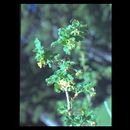mk
имиња во трошки


Ribes velutinum is a species of currant known by the common name desert gooseberry.[5]
It is endemic to the deserts and mountains of the Western United States. It is native to areas in Montana, Idaho, Washington, Oregon, Utah, Nevada, California, and Arizona),[6][7]
It grows in many types of habitat, including sagebrush scrub, pinyon-juniper woodland, and yellow pine forest.[5]
Ribes velutinum is a spreading shrub with a thick, arching, multibranched stem growing up to 2 meters (80 inches) long. Nodes along the stems are armed with spines which may reach 2 centimeters (0.8 inch) in length. These are spines, not prickles, as they are derived from leaf material rather than from the plant epidermis (skin).
The thick, leathery leaves have generally rounded blades divided shallowly into three or five lobes and dotted with glandular hairs. The small blades are borne on petioles.
The inflorescence is a solitary flower or raceme of up to four flowers. Each small flower is a tube of white or yellowish sepals with smaller, similarly colored petals inside. The bloom period is April and May.
The fruit is an edible berry one half to one centimeter (0.2-0.4 inch) wide which ripens yellow, then reddish or purple.[8][9]
Ribes velutinum is a species of currant known by the common name desert gooseberry.